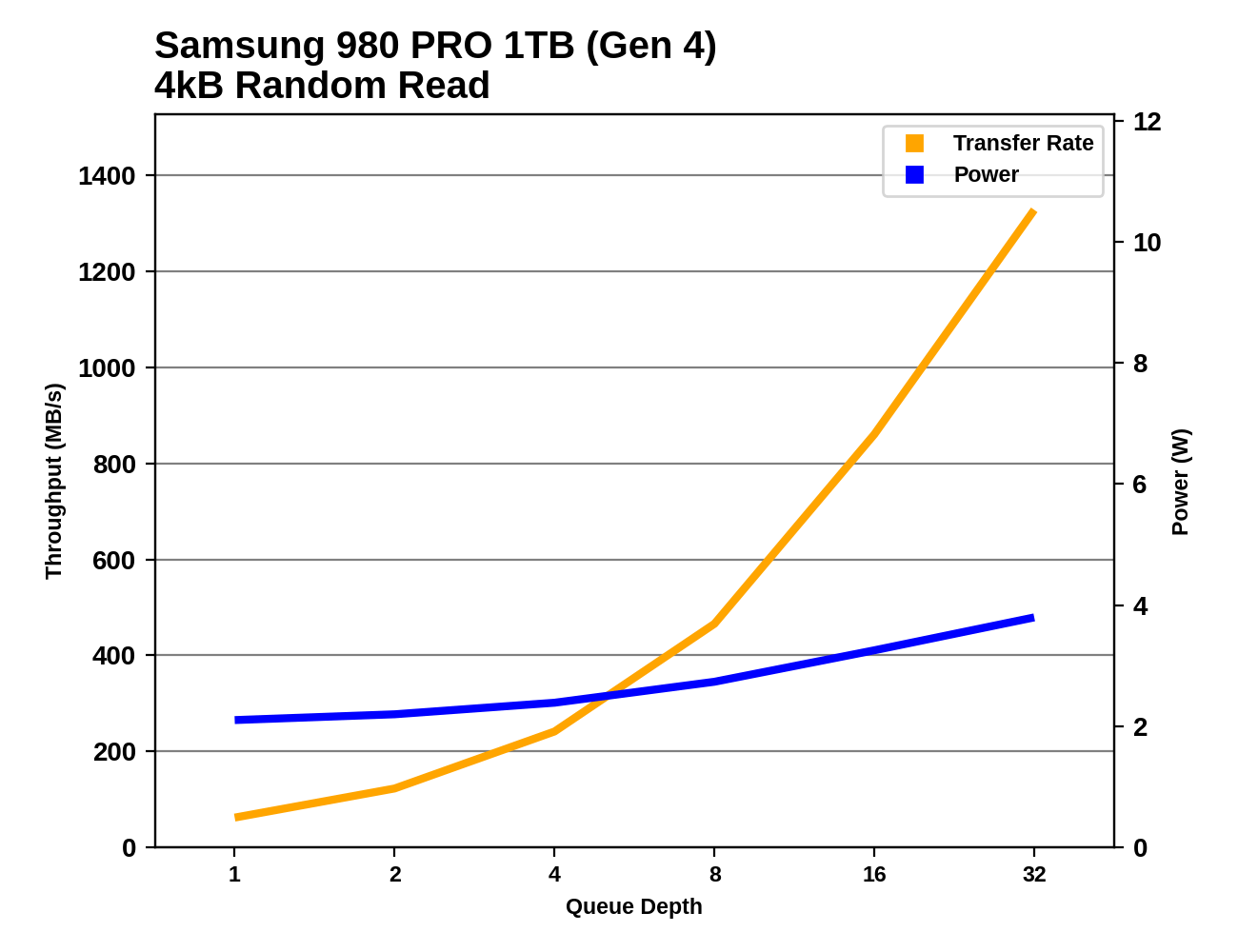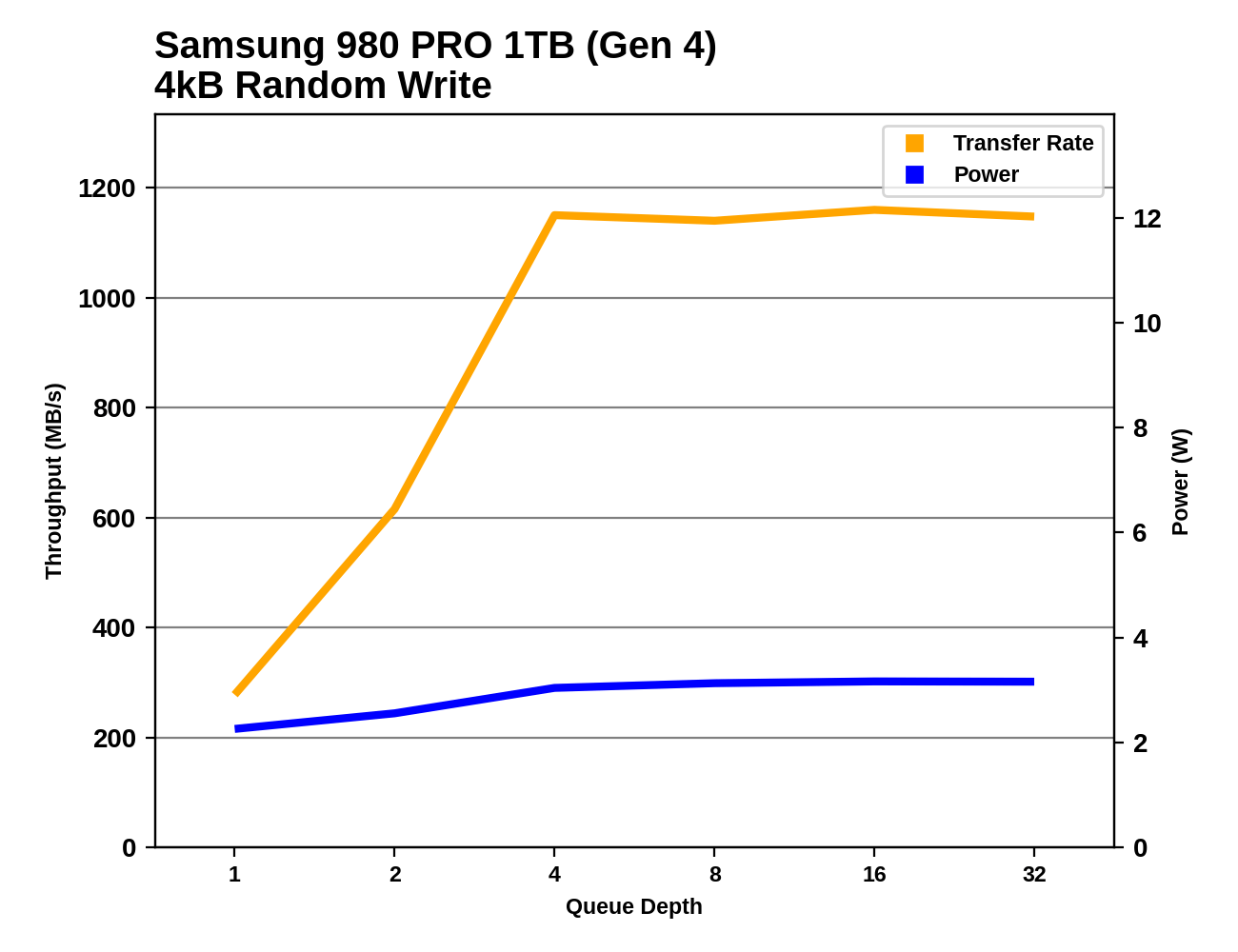The Samsung 980 PRO PCIe 4.0 SSD Review: A Spirit of Hope
by Billy Tallis on September 22, 2020 11:20 AM ESTNote: All our previous testing has been on an Intel test bed. Because of the move to PCIe 4.0, we have upgraded to Ryzen. Devices tested under Ryzen in time for this review are identified in the charts.
Random Read Performance
Our first test of random read performance uses very short bursts of operations issued one at a time with no queuing. The drives are given enough idle time between bursts to yield an overall duty cycle of 20%, so thermal throttling is impossible. Each burst consists of a total of 32MB of 4kB random reads, from a 16GB span of the disk. The total data read is 1GB.

The burst random read latency of Samsung's 128L TLC as used in the 980 PRO is faster than their earlier TLC, but still lags behind some of the competition—as does their 64L MLC used in the 970 PRO. Our new Ryzen testbed consistently imposes a bit more overhead on drives than our older Skylake-based testbed, and PCIe Gen4 bandwidth is no help here.
Our sustained random read performance is similar to the random read test from our 2015 test suite: queue depths from 1 to 32 are tested, and the average performance and power efficiency across QD1, QD2 and QD4 are reported as the primary scores. Each queue depth is tested for one minute or 32GB of data transferred, whichever is shorter. After each queue depth is tested, the drive is given up to one minute to cool off so that the higher queue depths are unlikely to be affected by accumulated heat build-up. The individual read operations are again 4kB, and cover a 64GB span of the drive.

On the longer random read test that adds in some slightly higher queue depths, the 980 PRO catches up to the 970 PRO's performance while the Phison-based Seagate drives fall behind. The SK hynix drive and the two drives with the Silicon Motion SM2262EN controller remain the fastest flash-based drives. Our Ryzen testbed has a slight advantage over the old Skylake testbed here, but it's due to the faster CPU rather than the extra PCIe bandwidth: the PCIe Gen3 drives benefit as well.
 |
|||||||||
| Power Efficiency in MB/s/W | Average Power in W | ||||||||
Samsung's power efficiency on the random read test is clearly improved with the new NAND and the 8nm Elpis controller, but that really only brings the 980 PRO's efficiency up to par at best. The SMI-based drives from Kingston and ADATA are a bit more efficient, and the SK hynix Gold P31 with its extremely efficient 4-channel controller is still far beyond the 8-channel competitors.
 |
|||||||||
Compared to the 970 EVO Plus, the 980 PRO's random read performance is increased across the board and power consumption is reduced, but the differences are slight. The 980 PRO's improvement is greatest at the highest queue depths we test, and running on our new Ryzen testbed helps a bit more—but the PCIe 3 SK hynix Gold P31 gets most of the same benefits at high queue depths and matches the QD32 random read throughput of the 980 PRO. We would need to use multiple CPU cores for this test in order to reach the performance levels where the 980 PRO could build a big lead over the Gen3 drives. The 250GB model shows more significant improvement than the 1TB model, but again this is mainly at high queue depths.
The random read performance and power consumption of the 980 PRO start out in mundane territory for the lower queue depths. At the highest queue depths tested, it is largely CPU-limited and stands out only because we haven't tested many drives on our new, faster Ryzen testbed. The PCIe Gen3 SK hynix Gold P31 is still able to keep pace with the 980 PRO under these conditions, and it still uses far less power than the competition.
Random Write Performance
Our test of random write burst performance is structured similarly to the random read burst test, but each burst is only 4MB and the total test length is 128MB. The 4kB random write operations are distributed over a 16GB span of the drive, and the operations are issued one at a time with no queuing.

The burst random write performance of the Samsung 980 PRO is an improvement over its predecessors, but Samsung's SLC write cache latency is still significantly slower than many of their competitors. PCIe Gen4 support isn't a factor for the 980 PRO here at QD1, and the two capacities of the 980 PRO seem to disagree whether the other differences between our old and new testbeds help or hurt. Meanwhile, the Phison E16-based Seagate FireCuda 520 does seem to be able to benefit significantly on our Gen4 testbed, where it takes a clear lead.
As with the sustained random read test, our sustained 4kB random write test runs for up to one minute or 32GB per queue depth, covering a 64GB span of the drive and giving the drive up to 1 minute of idle time between queue depths to allow for write caches to be flushed and for the drive to cool down.

On the longer random write test with some higher queue depths, it's more clear that our new Ryzen testbed performs a bit better than our old Skylake testbed, and that PCIe Gen4 support is only responsible for part of that advantage. Even using PCIe Gen4, the 1TB 980 PRO is not able to establish a clear lead over the PCIe Gen3 drives and is a bit slower than the Phison E16 drive, but the smaller 250GB 980 PRO is a big improvement over the 970 EVO Plus thanks to the larger SLC cache (now up to 49GB, compared to 13GB).
 |
|||||||||
| Power Efficiency in MB/s/W | Average Power in W | ||||||||
The 980 PRO brings significant and much-needed power efficiency improvements over its predecessors, and takes first place among the high-end 8-channel SSDs. But the 4-channel SK hynix Gold P31 still has a wide lead, since its random write performance is very competitive while its power requirements are much lower.
 |
|||||||||
The 1TB 980 PRO offers basically the same performance profile on this test as its predecessors from the 970 generation: performance tops out around QD4, where CPU overhead becomes the limiting factor. (This test is single-threaded, so higher throughput could be achieved on either testbed using a multi-threaded benchmark, but real-world applications need a lot of CPU power left over to actually *do something* with the data they're shuffling around.)
The 250GB 980 PRO briefly reaches the same peak performance as the 1TB model, but in the second half of the test it still overflows the SLC cache. It's a big improvement over the 250GB 970 EVO Plus, but the low capacity still imposes a significant performance handicap when writing a lot of data.
At QD1 the 980 PRO's random write performance is still in SATA territory, but it quickly moves to much higher performance ranges without much increase in power consumption. At the highest queue depths tested, the 1TB 980 PRO's performance is tied with the other CPU-limited drives and its power consumption is about midway between the fairly power-hungry Phison E16 drive and the stunningly efficient SK hynix drive.












137 Comments
View All Comments
msroadkill612 - Tuesday, October 13, 2020 - link
Yep. I find the raw sequential speeds exciting too - its not just about IOPS :)This processor load balancing coincides w/ some very handy advances in mainstream system memory - typically? 64GB (2x 32GB 3200 cl16 ~$220 atm) w/ speeds to ~45-50GB/s on AM4?,
a PCIE 4 GPU w/ a 32GB/s link vs the former 16GB/s. Its little mentioned, but seems an important plateau - ~64GB at 32GB/s seems a pretty usable supplemental tier of cache for the gpu?
quite possibly, nvme ports on the GPU's Infinity Fabric bus on ~BigNavi to bypass a potentially bottlenecked pcie bus - AMD did it before with a pro Vega card - an nvme raid array on the gpu.
individually they are increments in currently usable gaming memory & bandwidth (if not IOPS), but collectively they could be a force which affects gaming?
Games are what they are due to the restrictions of yore. Of course they are coded to isolate within gpu resources.. it was the only way to run fast enough. Reduce the restrictions tho, & add new usable resources, & games change to provide new & richer experiences.
MS FS is perhaps a forerunner of this new mindset - it likes massive memory, but is fun at 30FPS.
crabperson - Tuesday, September 22, 2020 - link
Thanks for the comparison to the PM1725a, I didn't realize how the lack of an SLC cache hurt it so much! I got a used 3.2 TB 'b version for a song, still holding out on Haswell here and probably won't upgrade until next year (Zen 3 may convince me otherwise).Looking forward to Phison's updated controllers and 2TB+ drives next year. Definitely don't need to waste money on the Pro line anymore.
Billy Tallis - Tuesday, September 22, 2020 - link
I was actually surprised how poorly the PM1725a fared on the consumer tests. I knew that the lack of SLC caching would hurt its writes, but it also appears to be heavily optimized for high queue depths at the expense of low queue depth performance.I'm planning to have some overlap between the enterprise and consumer synthetic benchmarks going forward, so there should be more opportunities to notice stuff like this.
ZeDestructor - Tuesday, September 22, 2020 - link
Any particular reson for not running the 3 desktop loads as well? I'm curious how the drives perform in more "real-world" desktop workloads tooBilly Tallis - Tuesday, September 22, 2020 - link
Time constraints, mostly. I grabbed the PM1725a because of its potential to show similar peak throughput, and it takes less than two hours to run the synthetic tests. A full set of ATSB results is a minimum of 12 hours plus however long it takes to fill the drive twice.ZeDestructor - Wednesday, September 23, 2020 - link
Couldn't you do it during downtime and then lump the results directly into bench? I'm not particularly fussed about having the results in this particular review, but they would be very nice to have around eventually™ for weirdos like me who buy used server drives for cheap and stick em into the desktop.PopinFRESH007 - Tuesday, September 22, 2020 - link
The Rocket 4 Plus was already announced and should be shipping this year with what looks to be better performance than this. Will be interesting to see what the price will be. The E18 also supports NVMe 1.4 rather than 1.3c on the 980 Pro.ToTTenTranz - Tuesday, September 22, 2020 - link
So.. is this a SSD that can go into the PS5 as expandable storage?Billy Tallis - Tuesday, September 22, 2020 - link
Probably. Sony hasn't put out their list of officially approved/tested SSDs yet, but this one should qualify and then some.UltraWide - Tuesday, September 22, 2020 - link
The RANDOM R/W scores are average. It looks like the SK Hynix is a better SSD for real world use.